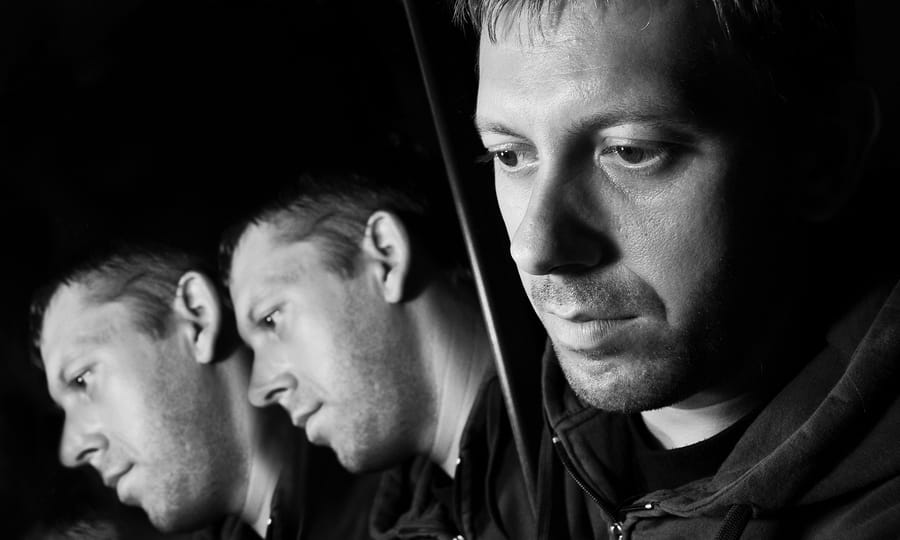Schizophrenia is a serious but somewhat uncommon mental disorder that affects between 0.25 and 0.64 percent of Americans (NIMH, 2018). A person with schizophrenia who is not receiving treatment will experience periods of time when they are disconnected from reality, usually experiencing a combination of hallucinations and delusions.
According to the American Psychiatric Association (2013), the disorder is characterized by at least 2 of the following symptoms, occurring in an individual for at least one month:
- Delusions
- Hallucinations
- Disorganized speech (e.g., frequent derailment or incoherence)
- Grossly disorganized or catatonic behavior
- A set of three negative symptoms (a “flattening” of one’s emotions, alogia, avolition; see below)
Sometimes a diagnosis can be made on the basis of only one of the above symptoms. This occurs when a mental health professional determines that a person’s delusions are bizarre or if the hallucinations consist of a voice keeping up a running commentary on the person’s behavior or thoughts, or the person hears two or more voices that seem to be conversing with one another.
- Delusions
- Hallucinations
- Disorganized thinking
- Agitation
- Affective flattening – The person’s range of emotional expression is clearly diminished; poor eye contract; reduced body language
- Alogia – A poverty of speech, such as brief, empty replies
- Avolition – Inability to initiate and persist in goal-directed activities (such as school or work)
Although the above symptoms must be present for at least one (1) month, there also needs to be continuous signs of the disturbance that persist for at least six (6) months in order for schizophrenia to be diagnosed. During this six-month period, the signs of the disorder may be present in a milder form. For instance, the person may only experience odd beliefs or unusual perceptual experiences. Also at least two of the above symptom criteria must be met during the six month period, or only the criteria of negative symptoms must be present — if even just in milder form.
Onset of schizophrenia prior to adolescence is rare. The peak age at onset for the first psychotic episode is early- to mid-20s for males and late 20s for females. Though active symptoms typically do not emerge until an individual is in their 20s, oftentimes prodromal symptoms — symptoms that show up before the full-blown disorder can be diagnosed — will precede the first psychotic episode, characterized by milder forms of hallucinations or delusions.
For example, individuals may express a variety of unusual or odd beliefs that are not of delusional proportions (e.g., ideas of reference or magical thinking); they may have unusual perceptual experiences (e.g., sensing the presence of an unseen person); their speech may be generally understandable but vague; and their behavior may be unusual but not grossly disorganized (e.g., mumbling in public).
Individuals with schizophrenia display large distress and impairments in various life domains. Functioning in areas such as work, interpersonal relations, or self-care must be markedly below the level achieved prior to the onset of the symptoms to receive the diagnosis (or when the onset is in childhood or adolescence, failure to achieve expected level of interpersonal, academic, or occupational achievement).
Schizoaffective disorder and mood disorder with psychotic features must be considered as alternative explanations for the symptoms and have been ruled out. The disturbance must also not be due to the direct physiological effects of use or abuse of a substance (e.g., alcohol, drugs, medications) or a general medical condition.
If there is a history of autistic disorder or another pervasive developmental disorder, the additional diagnosis of schizophrenia is made only if prominent delusions or hallucinations are also present for at least a month (or less if successfully treated).
It is thought that schizophrenia will appear in about 0.3% to 0.7% of the population, although it varies by race/ethnicity, across countries, and by geographic origin for immigrants and children of immigrants. The sex ratio differs across samples and population.
Hostility and aggression can be associated with schizophrenia, although spontaneous or random assault is uncommon. Aggression is more frequent for younger males and for individuals with a past history of violence, non-adherence with treatment, substance abuse, and impulsivity. It should be noted that the vast majority of persons with schizophrenia are not aggressive and are more frequently the victims of violence than the perpetrators of it. It is prejudicial and discriminatory to be fearful of a person with schizophrenia.
Entry has been updated for DSM-5; diagnostic code 295.90.
Types of Schizophrenia
The old criteria in the DSM-IV divided schizophrenia by different types. Though this specification is no longer used in the updated DSM-5, they remain below for informational and historical purposes.
A brief list of the different types of schizophrenia, according to the older DSM-IV, include:
- Paranoid schizophrenia — a person feels extremely suspicious, persecuted, grandiose, or experiences a combination of these emotions.
- Disorganized schizophrenia — a person is often incoherent but may not have delusions.
- Catatonic schizophrenia — a person is withdrawn, mute, negative and often assumes very unusual postures.
- Residual schizophrenia — a person is no longer delusion or hallucinating, but has no motivation or interest in life. These symptoms can be most devastating.
Learn more: Types of Schizophrenia
References
American Psychiatric Association. (2013). Diagnostic and statistical manual of mental disorders (5th ed.). Washington, DC: Author.
Beck, A.T., Rector, N.A., Stolar, N. & Grant, P. (2011). Schizophrenia: Cognitive Theory, Research, and Therapy. New York: Guilford Press.
Janicak, P.G., Marder, S.R., Tandon, R., Goldman, M. (2014). Schizophrenia Recent Advances in Diagnosis and Treatment. New York: Springer.
National Institute of Mental Health. (2019). Schizophrenia. Retrieved from https://www.nimh.nih.gov/health/publications/schizophrenia/index.shtml

